Illustrative Mathematics
Tilt of Earth's Axis and the Four Seasons
Geometry meets earth science as high schoolers investigate the cause and features of the four seasons. The effects of Earth's axis tilt features prominently, along with both the rotation of the earth about the axis and its orbit about...
Curated OER
Orbital Motion
Students use a formula to measure the eccentricity of an ellipse, then state Kepler's Law of Elliptical Orbits. They predict the solar energy received at different positions in a planet's orbit.
Curated OER
Equations of Lines Perpendicular and Parallel
In this algebra worksheet, students solve linear equations using one and two steps. They solve systems of equations using substitution and elimination with graphing. There are links for ready made tests and quizzes.
Curated OER
Worksheet 13
In this math worksheet, students write down the equation of a plane. Then they create the equation of a line. They also define the lines that are perpendicular.
Curated OER
Deep Impact Comet Encounter
Physics apprentices analyze the impact of NASA's Impactor as it collided with the comet Tempel 1 in July of 2005. They calculate the mass and speed of the comet, along with the distance it might drift off of its orbit over time. This...
Curated OER
Distance And Parallax
Students will determine distances to nearby stars using parallax. In this Astronomy lesson plan, students will use a web program, trigonometry, and sketches to determine the distance of stars.
Curated OER
Worksheet 34
In this math worksheet, students find the plane perpendicular to the path (t2, t, cos 2πt) at time t = 1/4. Then they determine the location in which the object is moving the fastest.
Curated OER
Parallax
Students discover how astronomers used the diameter of the Earth's orbit around the Sun as a baseline for estimating the distance of some stars, and the meaning of "Parsec" and "light year."
LABScI
Viscosity: The Fluid Lab
There's more to fluids than meet the eye—they include gases, liquids, and polymers, too! Scholars complete three hands-on activities exploring different properties of fluids. They explore viscosity by measuring the resistance, or...
Curated OER
Introduction to Conics
Just exactly where does the name conic come from? This brief hands-on exploration explains it all. Have your class cut cones to create their own conics, then assess their understanding with a few identification problems. Consider making...
Curated OER
Worksheet 24 Spring 1996
For this math worksheet, students find all the vectors in three dimensional space that have the length of 4. Also, the first and third components are the same. Finally, the second component is the sum of the first and third components.
Curated OER
Measuring the Diameter of the Sun
Ninth graders study the sun and its distance from Earth. In this Sun's diameter lesson plan students examine how measurement data permits accurate measurement of the sun's diameter.
Curated OER
Worksheet 10
In this math learning exercise, students determine if the information is used to describe a line. They examine the parametric and symmetric equations.
Curated OER
Globe Lesson 15 - The Changing Seasons - Grade 6+
In this changing seasons worksheet, learners read about the geography concept of changing seasons and then respond to 9 short answer questions.
Curated OER
Measuring the Diameter of the Sun
Students calculate and measure the diameter of the sun. They construct a meter stick instrument, calculate the diameter using a formula, and compare the measurement with the accepted scientific measurement.
















